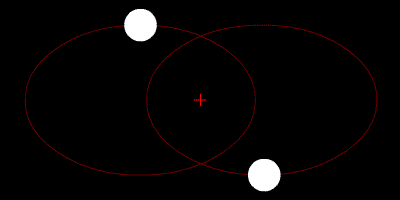I am surprised there isn't a thread for this, nor really that many shots posted, so I'll start off with this one...looks like a rogue gas giant


Last edited:

I am surprised there isn't a thread for this,



Here is a system which had two stars orbiting each other in unusual circular patterns, each with large planet arrays of their own:
It's a binary orbit with the barycenter outside both bodies, and the bodies both having eccentric orbits. For a good visualization of how bodies move in all kinds of two-body orbits, check the Gallery on the Barycenter Wikipedia article. Your example is this one:Wow, that is a weird system... Trying to visualize the possible ways these stars can be orbiting I only come with a completely synchronous orbit where the stars are circling in an opposite direction and are always both in the same (well, in an opposite kinda way) position of the orbit.




And here's a couple of extremely eccentric ELWs. Not my discoveries, but visited long ago, so their orreries are now visible to me from the galmap.


Here's a perfectly ordinary-looking system...
...or is it? Take a closer look at planets 6 and 7. That's right, they're a Trojan pair: Planet 7 is in one of Planet 6's Lagrange points (and, technically, vice-versa too). You'll notice they share exactly the same orbit, and form an equilateral triangle with each other and the central star - classical Lagrange Point geometry.
That's really cool! It's very nice to be able to see this clearly, in the new orrery. What is the mass of planet 6? For the system to be truly stable, they should have significantly different masses. That is, the larger object should have at least 25x the mass of the smaller, and even better if it's more like 100x. Otherwise it's a StellarForge "cheat".
Looking at the stats I posted in the thread I linked to above, planet 6 (Class III gas giant) is 1070 earth-masses, planet 7 (water world) is 1.76 E-Ms, so that's 607x - easily meeting your parameters.




